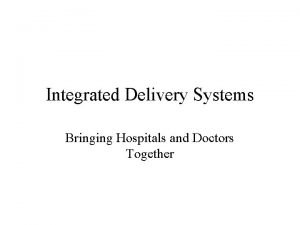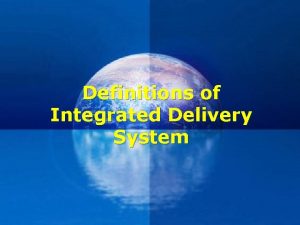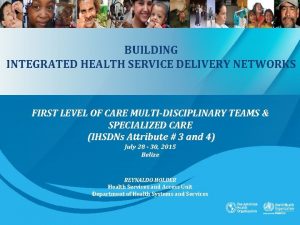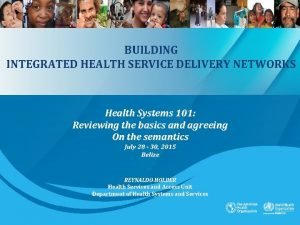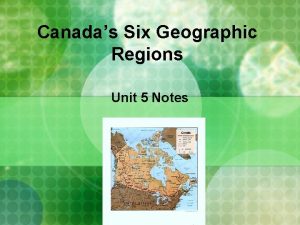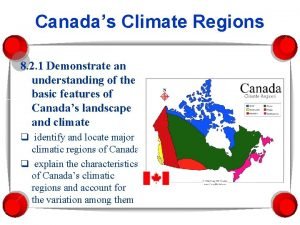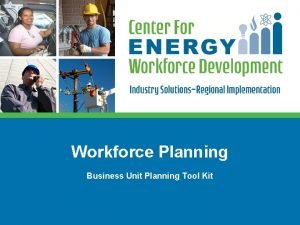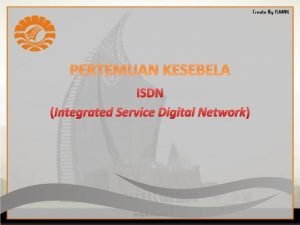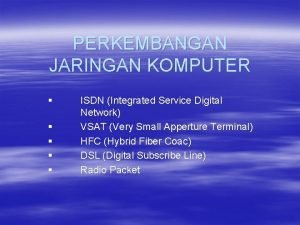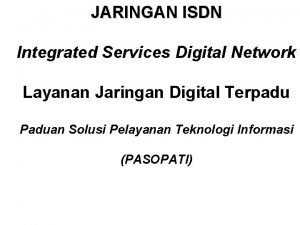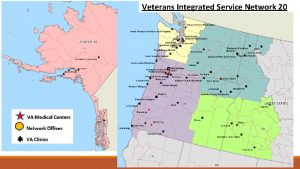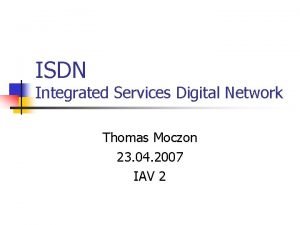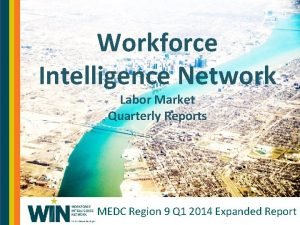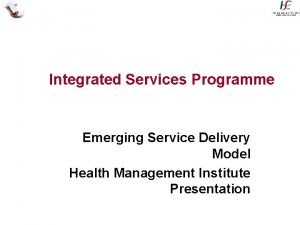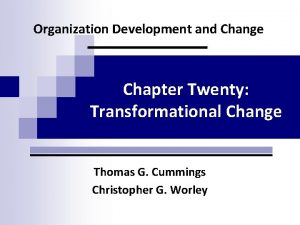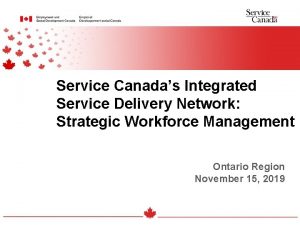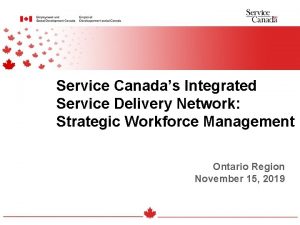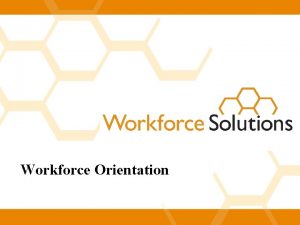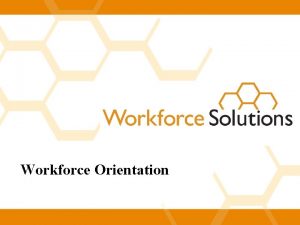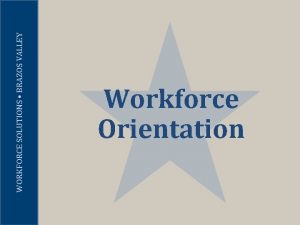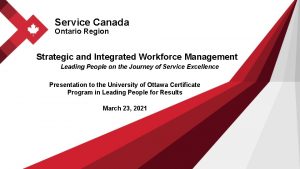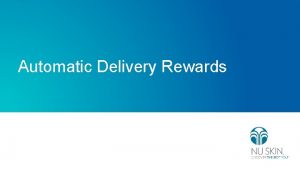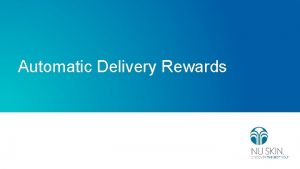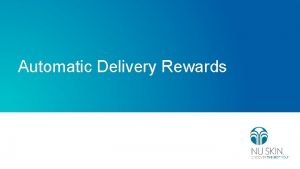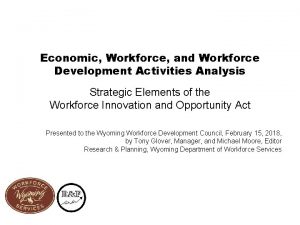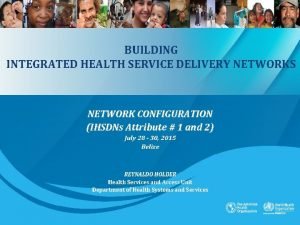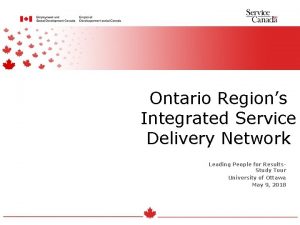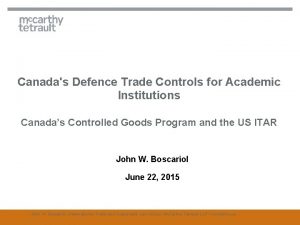Service Canadas Integrated Service Delivery Network Strategic Workforce




























- Slides: 28

Service Canada’s Integrated Service Delivery Network: Strategic Workforce Management Ontario Region November 15, 2019

SERVICE CANADA KNOWING OUR BUSINESS 1

SERVICE CANADA: PEOPLE SERVING PEOPLE Service Canada was created in 2005 as a single point of access for many government services. Integrated within the Employment and Social Development Canada portfolio, Service Canada delivers some of the Government of Canada’s largest and most wellknown programs and services. It operates within the legislative mandate and framework of the Department of Employment and Social Development Act, as part of the Portfolio. It now has the authority to deliver seamless client centric services for federal institutions and Canadian jurisdictions. The Department’s mission is to build a stronger, more competitive Canada, to support Canadians in making choices that help them live productive and rewarding lives and to improve Canadians' quality of life. 2

OUR EVOLVING NETWORK: THEN TO NOW 2005 Launch • • • The Delivery arm of HRSDC “How may I help you/Puis-je vous aider’’ Single point of access Multi-channel Brand awareness Client-centric approach from day one 2008 Economic Downturn • Impact on public policy • Partnerships (Work sharing & Joint rapid response action plan) • Community presence • Mobilize towards a common mandate • Implementation of the Service Management Structural Model to: • Better support ESDC/Service Canada business strategies, priorities and objectives • Facilitate the flow of work in an integrated channel management environment • Enable and support effective managerial control and employee support • Create meaningful and challenging roles that support progressive career pathing and succession planning 2010 Evolution of the Network • • • Fully integrated multi-channel service delivery Increased access for rural communities Self-service access to information 2011 DRAP • Implemented Delivery Operations Centre • Footprint redesign • Workforce adjustment • Leveraged governance and technology 2013 Policy vs Delivery • Passport and Service Canada • National Centres of Specialization • 2014 – OAS auto enrolment 2016 • EI Service Quality Review (SQR) • Community Outreach and Liaison Service (COLS) • Implementation of Management Services Branches in the Regions • Strengthened Federal, Provincial, Territorial Collaboration 2019 & Beyond • Transformation • Benefits Delivery Modernization 3

KNOWING OUR BUSINESS: INTEGRATED SERVICE DELIVERY IN ACTION Service Canada is the face of Government for many Canadians. We deliver a wide range of services and benefits, directly or through partners, that support individuals throughout their lives. 5 4

KNOWING OUR BUSINESS: UNDERSTANDING OUR OPERATING ENVIRONMENT Strategic human resource planning stems from a clear understanding of our business as well as the external and internal elements that make up the operating environment. This requires applying a strategic and holistic approach to ensure having the right people, in the right place at the right time in order to effectively deliver on business priorities. External Considerations • Changing external workforce demographics (e. g. multi-generational workforce) • Impacts of globalization, modernization, technological advancement and attracting the right talent to the public service • Social and economic shifts • Increased immigration and newcomer integration (e. g. increased need for client-focused, multi-lingual candidates to meet client group needs) • Labour market availability, skill shortages and ability to recruit in remote areas • Ability to recruit to meet distinct service needs (e. g. Indigenous language to support communication in Northern Ontario) Internal Considerations • Transformation and modernization initiatives • Changing skills sets as a result of increased automation • Maintaining bilingual capacity • Leadership development and succession planning • Knowledge retention and transfer • Changing internal workforce demographics (e. g. aging workforce) 5

SERVICE CANADA ONTARIO REGION LINKING WORKFORCE MANAGEMENT TO SERVICE EXCELLENCE 6

Organizational Design: The Way Forward to Service Excellence At the core of workforce management is Service Canada’s culture of service excellence. In support of this, Service Canada applies an overarching Service Excellence Workforce Framework (SEWF) which underpins and guides all aspects of workforce management. The Framework sets the standard for HR planning, including competency based recruitment, as well as enabling performance and talent management and lateral and upward career mobility for all staff. Through clearly defined business streams and strategic groups and levels of staff within the organization, as well as sizing guidelines that allow for Business Lines to be nimble and flexible, the Framework provides Regions with the ability to more effectively address service delivery requirements in a constantly evolving business environment. Regional Business Line structures are organized into two delivery channels: Operational and Service Delivery Business Expertise. Generic structures are interoperable and responsive, with flexibility to support the evolving scope and span of a continuous improvement business environment. Each delivery channel has clearly defined roles and responsibilities: Regional Service Delivery Operations is accountable for delivering programs and services through the application of integrated, cross-channel service delivery processes and managing workforce and workload deliverables to ensure performance targets are achieved. The Operational structure is comprised of all inperson, outreach, benefits delivery and investigative staff. Regional Service Delivery Business Expertise is responsible for integrating National policies, priorities and initiatives within the context of service delivery and ensuring operations have the appropriate resources in order to meet Departmental service objectives. 7

THE SERVICE EXCELLENCE WORKFORCE FRAMEWORK The Service Excellence Workforce Framework was strategically designed to respond to the Department’s Service Strategy and to promote a culture of Service Excellence. It is Service Canada’s foundational platform to enable the development of a holistic and integrated Workforce Strategy. 8

SERVICE CANADA ONTARIO REGION KNOWING OUR WORKFORCE 9

ONTARIO REGION: DATA, DATA AND MORE DATA Cumulative* Attrition Rate (2018 -2019 Q 2) 3. 50% Ratio of EX to Non-EX 1: 172 5863 EMPLOYEES 86. 68% Indeterminate 12. 38% Term 0. 94% Other** ADMO & Management Services Branch 43 Employees Strategic Services Branch 122 Employees Benefits Delivery Services Branch 3564 Employees 80. 93% PM 11. 94% CR 3. 45% NU 0. 58% EX 1. 72% AS 1. 38% EC/IS OTHER WORKFORCE STATS • 8. 60% OF WORKFORCE ON LWOP • 13. 85% BILINGUAL Citizen Services Branch 1341 Employees Business Expertise vs Operations 1: 10 Integrity Services Branch 467 Employees Program Delivery Branch 326 Employees 10

UNDERSTANDING OUR WORKFORCE Workforce Composition Key Elements Indeterminate Employees Term Employees Casual Workers Students New Hires Attrition Rate Leave Without Pay Bilingual Capacity Detailed workforce demographics ensure all facets of human resources are considered. Regular review of workforce demographics identifies: • when to hire, • where risks may arise, and; • where contingency actions may be required. It allows Ontario Region to apply a predictive approach to ensure informed, evidence based decision making in order to better manage, plan and anticipate workforce needs, recruitment strategies and financial impacts. Staff Movement in/out of Service Canada and cross Business Line 11

WORKFORCE DEMOGRAPHIC PROFILE 1341 326 467 3564 165 122 34 9 BDSB CSB PDB ISB SSB MSB ADMO *When conducting quarterly comparisons, figures will vary due to retroactive struck off strength, and delays in new hire entries. 12

WORKFORCE COMPOSITION AND EMPLOYMENT EQUITY 50101 700 AS CR EX NU PM EC/IS Student 34 202 4745 BDSB AS CR CSB EX PDB NU ISB PM SSB EC/IS MSB Student 0 5000 ADMO 13

ATTRITION AND LEAVE WITHOUT PAY Year-over-Year Attrition Rate -. . . 0% 3 , 8 18 . 17 -. . . 16 20 20 -. . . 0% 9, 7 3% 3 , 6 20 % 1 9. 4 15 20 20 14 -. . . 9. 7 -. . 8% 15, 00% 10, 00% 5, 00% 0, 00% 33 Indeterminate Term 471 Of the 5863 employees on strength, 504 are currently on LWOP which represents 8. 60% of the Regional Workforce. 14

AGE DISTRIBUTION AND RETIREMENT ELIGIBILITY Less than 25 25 -29 30 -34 35 -39 40 -44 45 -49 50 -54 55 -59 More than 60 0, 80% 8, 70% 15, 00% 15, 60% 15, 00% 13, 70% 12, 70% 10, 60% 7, 90% 15

WORKFORCE DEMOGRAPHIC REPORT 16

STRATEGIC AND INTEGRATED WORKFORCE MANAGEMENT: GUIDING PRINCIPLES Respect the Public Service Employment Act and Regulations Ø Workforce management activities will respect central agency and departmental policy and legislative instruments. Performance and Talent Management Ø Performance assessments and talent management plans will continue to be integrated into workforce management practices and approaches. Community Analysis Ø On-going community analysis will be governed by executive workforce management committees. Ø supports at level and/or promotional appointments of current regional indeterminate and term employees in advance of considering external hiring. Diverse and Inclusive Workforce Ø In alignment with the Diversity and Employment Equity Action Plan, a diverse and inclusive workforce will be supported using targeted staffing strategies to address existing and anticipated workforce representation gaps of designated employment equity groups. The Right People in the Right Place at the Right Time Ø Strategic and focused approaches will be employed to attract, recruit and retain the right complement of employees with the required competencies and skills to meet current and future operational needs. Commitment to Employee Development and Transparency Ø Management will discuss workforce management plans with employees to support transparency and employee understanding of the Region’s commitment to employee development and the mechanisms used to fill vacancies. Footprint, Accommodation and Official Language Considerations 17

STRATEGIC AND INTEGRATED WORKFORCE MANAGEMENT: FRAMEWORKS & STRATEGIES Strategic and integrated workforce planning is the driver of all workforce management activities within Ontario Region. A strong and cohesive governance framework supports the regional priorities outlined in the Integrated Service Delivery Plan. Strategic frameworks and guidelines, guided by key principles, act as the building blocks to maintain an open, diverse and accessible workforce. Open, Diverse and Accessible Workforce Stra tegi c and Inte grat ed Wor kfor ce Plan ning Strategic Recruitment Framework Strategic External Recruitment and Outreach Framework Indigenous Recruitment and Retention Framework Performance and Talent Management Frameworks Student Hiring Framework Workforce Movement Framework Casual Hiring Guidelines Official Languages and Skills Development Framework 18

STRATEGIC RECRUITMENT FRAMEWORK: KEY COMPONENTS In the 2018 -2019 fiscal year, the Strategic and Integrated Workforce Management Committee (SIWMC) approved 3666 staffing actions including: Maximize Staffing Flexibilities • Cross-Business Line Collaboration Performance and Talent Management 787 advertised staffing actions (includes indeterminate, term and acting appointments) • 1930 non-advertised staffing actions (includes indeterminate, term and acting appointments) - includes 608 term to indeterminate (retention) appointments Recruiting, Developing and Retaining a Workforce Targeted bilingual and employment equity recruitment Employ strategic marketing approaches Leverage continuous and post-secondary recruitment inventories Promote value of selfidentification • 415 Deployments • 137 Assignments • 297 Student Employment • 40 Secondments • 60 Other (includes duty to accommodate) *Of these staffing actions, 727 were based on talent management plans. 19

STAFFING FLEXIBILITIES Service Canada, Ontario Region is committed to using all staffing flexibilities, including a mixed use of advertised and non-advertised processes, to recruit, retain and develop the right talent to meet current and future business needs. Advertised selection processes support recruitment for: • Entry-level positions, • Positions with high turn-over, and; • Positions requiring experience, knowledge and skills that are not readily available within. vs. Non-Advertised • Enables employees to play a larger role in terms of career development and progression • Allows employees an opportunity to demonstrate their abilities, skills and suitability for other positions on a daily basis rather than during a ‘moment-in-time’ (traditional advertised assessment). • Positions sub-delegated managers to make informed, right-fit decisions based on proven ability, potential and suitability. 20

MANAGING OUR TALENT Talent management connects the performance, potential and career aspirations of employees to the current and future business needs of the organization. An integrated talent management approach ensures an organization can attract, motivate, develop and retain its most critical investment – its people. Talent mapping provides an integrated process of identifying, developing and retaining high performing employees within the organization. It is a means of: • Accelerating employee development by identifying opportunities for career growth and leadership development • Identifying current and potential talent bench strength • Enabling appropriate knowledge transfer • Evaluating and planning for critical/key positions Talent development activities support the development of employee skills and competencies to meet the needs of the organization through: • On-the-job training • Exposure and networking • Learning and development • External Training Ontario Region’s goal is to support employees in their development to achieve their full potential. 21

TALENT MANAGEMENT APPROACH The talent management path serves as the organization’s proactive approach for optimizing the performance, potential and career aspirations of employees. Onboarding of new employee D E V E L O P M E N T Learning and developing employee in their substantive position through the Learning Roadmap Assess performance against work objectives (i. e. quality, productivity etc. ) and core competencies Identify and select employees for talent management Determine appropriate talent development activities* Match skills of talent managed employees to the needs of the organization * If acting is chosen as the talent development activity then: 1. Assess talent managed employees in their new position 2. Appoint qualified candidates through non-advertised staffing mechanism 22

LEADERSHIP RETENTION AND DEVELOPMENT • Regular senior-level meetings are scheduled to support a holistic and integrated regional vacancy management approach for leadership positions. • This approach ensures continued rigor, consistency and transparency in the movement and development of employees in leadership positions. • A Leadership Learning Roadmap and formalized coaching and mentoring provide additional support. • All executives and senior managers have a designated back-up in place for coverage during periods of absences. This ensures consistency in approach and supports the learning and development of aspiring executives. 23

ENGAGING, DEVELOPING AND RETAINING A WORKFORCE In order to support a high-performing organization, Ontario Region is committed to supporting, developing and engaging a workforce that is committed to providing the highest quality service. Employee learning and development is supported throughout the career cycle through various tools and supports including: Onboarding Learning Roadmaps Workforce Analysis Second Official Language Development Ongoing Engagement • Ontario Region Onboarding Framework and New Employee Onboarding Roadmap ensure effective integration of employees into the Service Canada network providing employees with a clear understanding of their accountabilities as public servants, as well as the service priorities of the Department. • Learning Roadmaps that support the operational and developmental learning paths for specific groups (Service Delivery Business Expertise, Leadership, Executive, Administrative Professionals etc. ) • A cross-business line approach to analysis of skills gaps and needs assessment to support staff mobility and to develop/expand skills and expertise. • Implementing an Official Languages Skills Development Framework to promote bilingualism in the workforce and maximize departmental offerings to support staff. • Promoting participation in various committees and communities of practice to engage staff and support career progression; ongoing coaching and mentoring. 24

LEVERAGING PERFORMANCE MANAGEMENT • Performance management is an ongoing process that involves planning, developing, coaching, providing feedback and evaluating employee performance. • Formal discussions between Leaders and employees occur at three points in the performance management annual cycle (beginning of year, mid-year, year-end). • Regular performance discussions outside of the three specific points are a critical part of employee development. • For employees to consistently grow and develop, it is important that they receive continuous and timely feedback from their Leader. • In Ontario Region’s performance management program, ‘how’ the work gets done is equally weighted with ‘what’ work gets done. • At year-end, Leaders provide ratings for work objectives (what work gets done) and core competencies (how work gets done). 25

CONNECTING THE DOTS: FROM DATA ANALYSIS TO WORKFORCE DECISIONS KNOWING OUR BUSINESS Integrated Service Delivery KNOWING OUR WORKFORCE Demographics & Statistics Ensuring all workforce practices are grounded on SERVICE CANADA’S SERVICE EXCELLENCE WORKFORCE FRAMEWORK Developing FRAMEWORKS, STRATEGIES AND GUIDELINES RECRUIT, DEVELOP AND RETAIN UNDERSTANDING OUR WORKFORCE Strategic & Integrated Workforce Planning Strategic Workforce Management Decisions 26

Questions?
 What are the advantages of an integrated delivery network?
What are the advantages of an integrated delivery network? Integrated delivery network definition
Integrated delivery network definition Integrated delivery network
Integrated delivery network Health service delivery network
Health service delivery network Temperatura en las cañadas del teide
Temperatura en las cañadas del teide Canadas landforms
Canadas landforms 90 of the canadian population lives within
90 of the canadian population lives within Whats canadas longest river
Whats canadas longest river Unit 5 food national geographic
Unit 5 food national geographic Canadas head of state
Canadas head of state What is canada's economic system
What is canada's economic system Electromagnetismo
Electromagnetismo Physical regions in canada
Physical regions in canada Canadas climate
Canadas climate Strategic workforce planning toolkit
Strategic workforce planning toolkit Strategic workforce
Strategic workforce Strategic workforce planning swp
Strategic workforce planning swp Integrated service digital network
Integrated service digital network Integrated service digital network
Integrated service digital network Fungsi isdn jaringan
Fungsi isdn jaringan Va visn 20
Va visn 20 Ntba wiki
Ntba wiki Workforce intelligence network
Workforce intelligence network Building information modeling ppt
Building information modeling ppt Integrated services delivery
Integrated services delivery Aia integrated project delivery
Aia integrated project delivery Characteristics of transformational change
Characteristics of transformational change Three application delivery approaches
Three application delivery approaches Strategic fit vs strategic intent
Strategic fit vs strategic intent
